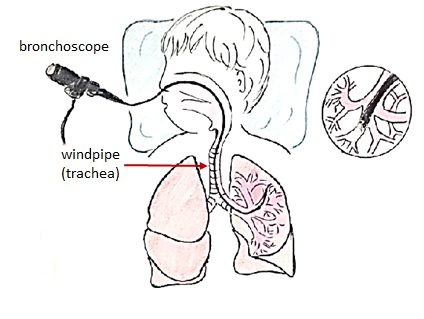Bronchoscopy (Flexible)
What is flexible bronchoscopy?
Flexible bronchoscopy allows us to examine the air passages of the lung. During a flexible bronchoscopy, the doctor uses a flexible tube with a light and a video camera (called a bronchoscope) to look at the air passages of the lung. The thin tube goes through the nose, mouth, or down a breathing tube into the windpipe (trachea). Then, the doctor examines the airways (bronchi) to each lung. The bronchoscope can remove unwanted secretions or take lung fluid for review in the laboratory. An image of the airways shows up like a movie on a video screen while the procedure is happening.

Why does my child need a Bronchoscopy?
- Airway abnormality: Airway abnormalities can occur before birth as the lungs are developing. The most common abnormality is called “malacia” or softening of an airway wall. This can occur in the windpipe (tracheomalacia) or large airways (bronchomalacia). A large heart or abnormal blood vessels close to the airway system can partially collapse an airway. Changes in the airways of the lung can occur after birth for many reasons: prolonged use of a breathing tube can injure the airway; infectious and non-infectious diseases can affect the airway; inhaling a peanut or other substance, trauma, or smoke inhalation from a house fire can injure the air passages.
- Secretion removal: The tubes of the airway system are very small and can become clogged with secretions (mucus, blood, or pus). Secretions may be difficult to remove with a breathing tube in place. Bronchoscopy is performed to remove these secretions out of the airway and allow air to move in and out of the lung normally.
- Infection: An infant or child may have a chest exam or chest x-ray that suggests infection in the lung. Bronchoscopy allows us to reach an area of the lung and gather lung fluid for review.
- Bleeding: When an infant or child coughs up blood or blood appears in the breathing tube it is important to know where the bleeding is from. Even limited bleeding can signify a major problem like local trauma to the airway, an airway tumor or inhaled hard object (pen top, part of a plastic toy). When bleeding is heavy the problem can become serious very quickly and it is important to find the source of bleeding so the correct therapy can be chosen to help your child.
- Other reasons: Bronchoscopy is often used to help diagnose the cause of chronic cough. Sometimes an infant or child has very noisy and unusual breathing and the reason may be discovered by looking inside the airways. In the intensive care unit we may perform bronchoscopy to place or check the position of a breathing tube. Your doctor will explain to you why bronchoscopy is being performed.
Will my child be comfortable?
Your child will receive
- Pain medicine to help with pain or discomfort during the procedure
- A numbing medicine (anesthetic) is sometimes sprayed in the throat and/or nose when a breathing tube is not in place. It helps to lessen gagging and coughing as the bronchoscope is placed into the throat. The medicine my taste unpleasant but that will go away
- Sedation medicine to sleep or relax during the procedure
What are alternatives to flexible brochoscopy?
Rigid bronchoscopy allows an ear, nose, and throat surgeon to treat an airway problem with special instruments that are not available through a flexible bronchoscope. Special x-ray procedures (CT scan, MRI) are sometimes used to diagnose airway problems. Your doctor will use the least risky and most effective procedure or test to help your child.
What are risks to flexible brochoscopy?
Risks may be related to the procedure itself or to the sedative or numbing medicine. Bronchoscopy is a low risk procedure. Sometimes the risks may be higher due to the type and extent of illness.
Examples of risks may include
- Decreased oxygen level: Flexible bronchoscopy can interfere with the delivery of oxygen whether a child has a breathing tube or breathing on their own. Your doctor will have a plan for keeping your child’s oxygen in a healthy range.
- Bleeding: The inside lining of the airway wall can be fragile especially if infection is present. The tip of the bronchoscope can scratch the airway lining and cause bleeding. The bleeding is almost always minimal and resolves on its own. If bleeding becomes more severe there are a number of steps that can be taken to stop the bleeding. Most infants and children are not at risk for bleeding but your doctor can create a plan for bleeding if there is concern.
- Air leak: Injury to the lung can rarely occur during bronchoscopy. Air will leak out of the lung and become trapped outside the lung but inside the chest wall. An emergency occurs when too much air leaks from the lung and interferes with lung and/or heart function. This air must be removed as soon as possible either by placing a needle or small tube through the chest wall to release the air.
- Other: Infants and children with heart disease can develop a change in heart rate and/or rhythm. On rare occasion these changes may require treatment. Bronchospasm or the acute narrowing of the air tubes similar to an asthma attack can occur. These events are also uncommon and therapy is available to reverse the problem.
Questions?
This information is not specific to your child but provides general information. If you have any questions, please speak to your doctor.
This page is not specific to your child, but provides general information on the topic above. If you have any questions, please call your clinic. For more reading material about this and other health topics, please call or visit Children's Minnesota Family Resource Center library, or visit www.childrensmn.org/educationmaterials.
© 2024 Children's Minnesota
